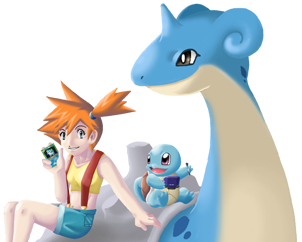I've always wondered about something, on identifying Pokémon cards. Of course, the most robust way is to use its set followed by its number: that's how Redshark does it. But a long time ago, when I played the Pokémon TCG Game Boy game, I noticed something: the cards were identified by their "levels". In the American base set cards until the first e-Reader deck or so, there were levels printed on the bottom of Pokémon cards. I also recall that the Japanese cards from that same era printed their levels in a subscript on the top of them, by their HP (see Rattata Japanese Vending Set 1). When e-Cards came around, the levels, along with flavor information such as weight, disappeared, presumably to make room for the e-Reader scan-code. Since then through the third generation, no new cards in any nation had levels.
You know, since that Game Boy game, I've had the habit of calling and identifying Pokémon cards by their levels, like "Pidgeotto Lv.36". It feels to me so much better, less dry, and less technical than "Pidgeotto Base Set No. 22" or "Pidgeotto BS-22".
So imagine my surprise when I saw that with the first Diamond/Pearl sets, levels were back, right next to the names of Pokémon. I thought, "Yay! They're back!" It added a flavor to the game for me. I would be able to use levels to name cards again.
But in the new Legend era of cards for HeartGold and SoulSilver, the card makers have removed levels again, this time for no dot code or any other apparent reason. Maybe they thought that levels were giving people the wrong idea about superiority or usefulness between cards. Maybe they didn't want to keep track of levels anymore. Who knows? I'd love someone to ask them. (If you ever interview a guy who works with them, please do!)
Now, I know that there are plenty of disadvantages for canonically identifying Pokémon by level. First of all, it doesn't identify those non-Pokémon cards that happen to be different yet share the same name. Second, it alone only can identify up to a hundred varieties of Pokémon cards with the same name, and if two cards share the same level and name you need to say something else. With all Arceus cards being at Lv.100, for instance, you'd have to say something like "Arceus-Grass" instead. Or if there happened to be two Rattata at Lv.10 in one deck, you'd have to say things like "Rattata-with-Gnaw" and "Rattata-with-Bite".
Why can't I just use set names? Because it sounds so artificial to me. I kind of see sets as arbitrary boundaries between cards, and even though it's the one way to always unambiguously refer to a card, it's a pain for me. Even using attack names is better than set names, but yet I yearn for levels. "Rattata-level-fifteen" sounds so much better than "Rattata-vending-ess-one".
Where am I going with this? Um...I'm just expressing a part of Pokémon that was always odd for me. How do you refer to your cards, beyond their names? By attack? By type? By actually saying the set name? Or (heart aflutter) by level?
You know, since that Game Boy game, I've had the habit of calling and identifying Pokémon cards by their levels, like "Pidgeotto Lv.36". It feels to me so much better, less dry, and less technical than "Pidgeotto Base Set No. 22" or "Pidgeotto BS-22".
So imagine my surprise when I saw that with the first Diamond/Pearl sets, levels were back, right next to the names of Pokémon. I thought, "Yay! They're back!" It added a flavor to the game for me. I would be able to use levels to name cards again.
But in the new Legend era of cards for HeartGold and SoulSilver, the card makers have removed levels again, this time for no dot code or any other apparent reason. Maybe they thought that levels were giving people the wrong idea about superiority or usefulness between cards. Maybe they didn't want to keep track of levels anymore. Who knows? I'd love someone to ask them. (If you ever interview a guy who works with them, please do!)
Now, I know that there are plenty of disadvantages for canonically identifying Pokémon by level. First of all, it doesn't identify those non-Pokémon cards that happen to be different yet share the same name. Second, it alone only can identify up to a hundred varieties of Pokémon cards with the same name, and if two cards share the same level and name you need to say something else. With all Arceus cards being at Lv.100, for instance, you'd have to say something like "Arceus-Grass" instead. Or if there happened to be two Rattata at Lv.10 in one deck, you'd have to say things like "Rattata-with-Gnaw" and "Rattata-with-Bite".
Why can't I just use set names? Because it sounds so artificial to me. I kind of see sets as arbitrary boundaries between cards, and even though it's the one way to always unambiguously refer to a card, it's a pain for me. Even using attack names is better than set names, but yet I yearn for levels. "Rattata-level-fifteen" sounds so much better than "Rattata-vending-ess-one".
Where am I going with this? Um...I'm just expressing a part of Pokémon that was always odd for me. How do you refer to your cards, beyond their names? By attack? By type? By actually saying the set name? Or (heart aflutter) by level?

